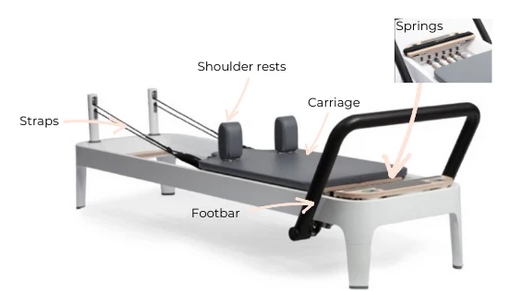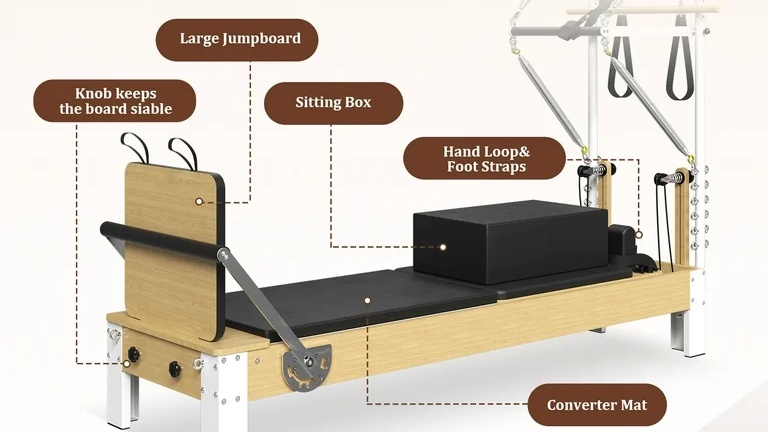The Pilates Reformer is a special piece of gym equipment that helps you exercise in a gentle, controlled way. It uses springs to provide adjustable resistance, making it useful for many kinds of workouts. Let's take a closer look at each part and what it does.
✅ 1. Carriage
The carriage is the flat, cushioned part you lie or sit on during your workout. It moves smoothly along rails under the frame. The carriage moves based on the force you apply, and it's supported by wheels or rollers. Springs under the carriage provide resistance to your movements, making it the main moving part of the Reformer. Smooth movement and the right amount of resistance are important for proper form and muscle use. Some Reformers also have adjustable headrests for neck support when you're lying down.
✅ 2. Springs
Springs are the key part that gives the Reformer resistance. They are often colored to show how strong they are, from light to heavy. These springs are attached under the carriage and connect to the frame. You can add or remove springs to change how hard or easy the workout feels. Springs offer resistance in both directions, which helps control your movement and supports your joints. This is different from using free weights, which can put more stress on your body.

✅ 3. Straps and Handles
Straps are connected to pulleys at the end of the Reformer. They can be gripped with your hands or feet to help with exercises. Handles or loops at the ends make it easier to hold on during movements. The pulley system helps with smooth and adjustable motion, allowing you to target different parts of your body. Some Reformers also have different handles or ankle cuffs to increase variety in your workouts.
✅ 4. Footbar
The footbar is a padded bar at one end of the Reformer. You use it to push off with your feet or hands during movements. Its height and angle can be adjusted to fit your needs. The footbar is important for exercises like leg workouts, lunges, and push movements. It gives you support and helps you apply resistance against the springs.
We are committed to delivering exceptional support and
top-tier service whenever you need it!
✅ 5. Shoulder Blocks
Shoulder blocks are padded supports on the carriage near the headrest. They help keep your shoulders in the right position during exercises that you do while lying down. These blocks stop your shoulders from sliding forward, which enhances safety and helps you focus on the right form.
✅ 6. Headrest
The headrest supports your neck and head when you're lying down on the carriage. It's often adjustable so it can fit different body sizes and offer better comfort. Good head support helps you keep your spine aligned and prevents neck strain during exercises.

✅ 7. Frame and Rails
The frame is the main structure of the Reformer and is usually made of wood, aluminum, or steel. It holds the rails, which are long metal tracks that the carriage moves on.
The rails guide the carriage smoothly and help control the movement. A strong frame is important for safety and stability, especially when you're doing more intense workouts.
✅ 8. Tower or Vertical Frame (Optional Accessory)
Some Reformers come with a Tower, which is a vertical frame attached to the main unit. The Tower provides more options for resistance with extra springs, bars, and pulleys. It allows you to do standing exercises, pulling, and pushing workouts, making the Reformer even more versatile. The Tower also has higher pulley placements and push-through bars, giving you more ways to target different muscles.
✅ How the Parts Work Together?
During a workout, you lie or sit on the carriage, and use the straps or footbar to start moving. As the carriage slides along the rails, the springs create resistance, helping you work your muscles while staying in control. The shoulder blocks and headrest keep your body in the right position and help you stay safe.
Using different springs, adjusting the footbar, or changing strap lengths lets you tailor your workout to your fitness level or needs. The design of the Pilates Reformer helps you combine resistance training with proper body alignment and mindful movement, making it a great tool for strength, flexibility, balance, and coordination.

Talk To Our Experts
Connect with an NQ expert to discuss your product needs
and get started on your project.
✅ FAQs
What is the function of the carriage on a Pilates Reformer?
The carriage is the sliding platform that supports the user's body during exercises. It moves smoothly back and forth on rails, allowing controlled dynamic movement. Its smooth glide and cushioning provide both comfort and stability, enabling a wide range of motions while the springs offer resistance.
How do the springs affect workout intensity on a Reformer?
Springs control the level of resistance by offering push and pull tension. They come in different strengths, usually color-coded for easy identification. Adding more springs or choosing higher-tension springs increases resistance, making exercises more challenging, while fewer or lighter springs reduce the load, ideal for beginners or rehab.
What role do the straps and handles play in Reformer exercises?
Straps and handles connect to ropes and pulleys, allowing users to engage their arms and legs in resistance work. They facilitate smooth pulling or pushing motions and add versatility by supporting a variety of exercises targeting different muscle groups, from upper body to legs and core.
Why is the footbar adjustable and how is it used?
The footbar provides a solid point of leverage for the feet or hands during exercises. Its adjustability in height and angle accommodates different body sizes and allows users to modify the intensity or target specific muscles by changing foot placement—heels, toes, or arches.
How do shoulder blocks enhance safety and performance?
Shoulder blocks prevent the shoulders from sliding forward during lying exercises, ensuring proper alignment and stability. They help maintain correct posture, reducing the risk of injury, and allowing users to focus on controlled, precise movements.
What materials are typically used for the Reformer frame and rails, and why does it matter?
Frames are commonly made from hardwood, aluminum, or steel. Hardwood offers a classic aesthetic and sturdy feel, while aluminum and steel provide durability and lighter weight. The rails must be smooth and strong to support the carriage's motion. A well-built frame ensures stability, safety, and longevity.
What is the purpose of the Tower or vertical frame attachment?
The Tower adds vertical resistance options with extra springs, bars, and pulleys. It allows for standing and pulling exercises, expanding the range of movements beyond what the carriage and footbar alone offer. This accessory increases the Reformer's versatility, making it suitable for more advanced workouts and targeted muscle training.
Post time: Aug-08-2025
